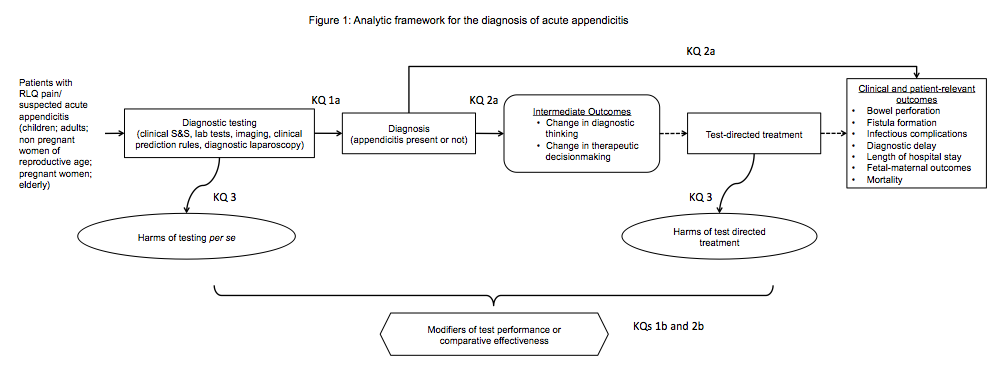Code the Following Diagnosis Acute and Chronic Appendicitis
An established patient is seen for management of diabetes and hypothyroidism and the physician spends equal time on each diagnosis. It is different from acute appendicitis but it can also have serious complications.
Abdominal pain is the most common symptom of chronic appendicitis.

. Assign the code for suspected carrier of group B strep. K3532 Acute appendicitis with perforation and localized peritonitis without abscess. K353 Acute appendicitis with localized peritonitis.
ICD-10-CM Diagnosis Code M70039. Examples Acute and chronic appendicitis 5409 and 542 Note. A single code used to classify any of the following.
Subacute and chronic pyelonephritis. As of October 1. 2016 2017 2018 2019 2020 2021 2022 BillableSpecific Code.
K36 Other appendicitis. Chronic appendicitis is a long-term condition characterized by appendicitis symptoms that come and go over time. There is controversy as to whether this actually represents a true disease since acute appendicitis is the typical manifestation of an inflamed appendix.
Chronic appendicitis is a disorder caused by inflammation of the appendix that extends over a period of time. Unspecified acute appendicitis. K3580 is a billablespecific ICD-10-CM code that can be used to indicate a diagnosis for reimbursement purposes.
Chronic appendicitis is different from acute appendicitis. Home 2013 ICD-9-CM Diagnosis Codes Diseases Of The Digestive System 520-579 Appendicitis 540-543 Acute appendicitis 540- A disorder characterized by acute inflammation to the vermiform appendix caused by a pathogenic agent. Using the ICD-10-CM code the following.
Ordinarily the code number listed with the main term entry for example the main terms Appendicitis or Arrhythmia is for. K352 Acute appendicitis with generalized peritonitis. Acute and chronic appendicitis.
In children the clinical manifestations of appendicitis are variable. K353 Acute appendicitis with localized peritonitis. When the Index does not provide a subentry for a condition described as subacute code the condition as acute.
Chronic appendicitis is a rare condition that involves long-term swelling of the appendix which is a small piece of tissue at the bottom of the large intestine. Which of the following diagnosises should be coded and reported as the principal diagnosis. The chronic diagnosis is coded first and the acute diagnosis is coded 2nd.
K36 is a billable diagnosis code used to specify a medical diagnosis of other appendicitis. The 2022 edition of ICD-10-CM K3580 became effective on October 1 2021. 2016 2017 2018 2019 2020 2021 2022 BillableSpecific Code.
K3580 Unspecified acute appendicitis. Corneal ulcer with hypopyon of left eye. Crepitant synovitis acute chronic unspecified wrist.
K3530 without perforation or gangrene. K35 Acute appendicitis. Two diagnoses a diagnosis with an associated secondary condition or a diagnosis with an associated complication.
Acute appendicitis is the most common form. False it is not a dual code it is a COMBINATION code. When there are no subentries for acute subacute or chronic disregard these modifiers in coding the particular condition.
K3589 Other acute appendicitis. The 2022 edition of ICD-10-CM K36 became effective on October 1 2021. Your coding an office visit and you have 2 different unrelated diseases to ICD-9 code.
Acute recurrent appendicitis is more common than chronic appendicitis. The code K36 is valid during the fiscal year 2022 from October 01 2021 through September 30 2022 for the submission of HIPAA-covered transactions. Synovitis wrist crepitant chronic.
ICD-10 codes for Appendicitis. The ICD-10-CM code K36 might also be used to specify conditions or terms like atypical appendicitis catarrhal appendicitis chronic. To assign a code for serositis serositis would need to meet ACS 0002 Additional diagnoses and be documented as multiple or peritoneal serositis as these terms are essential modifiers at the.
K36 is a billablespecific ICD-10-CM code that can be used to indicate a diagnosis for reimbursement purposes. Appendiceal disease can be acute acute recurrent or chronic. Acute and chronic tracheobronchitis.
1 the patient has a history of RLQ pain of at least 3 weeks duration without an alternative diagnosis. This is the American ICD-10-CM version of K36 - other international versions of ICD-10 K36 may differ. K3533 Acute appendicitis with perforation and localized peritonitis with abscess.
The symptoms of chronic appendicitis tend to be milder. One diasnosis is acute and the other is a nonacute diagnosis. Chronic appendicitis occurs with an incidence of 1 and is defined by the following.
Appendicitis is one of the most common causes of acute abdominal pain with a lifetime risk of 86 in males and 67 in females1 It is the most common nonobstetric surgical emergency during. Patients who have an appendicolith usually develop appendicitis often with perforation. For the scenario cited VICC advises to assign K358 Acute appendicitis other and unspecified because the Index entries at Appendicitis do not contain with serositis.
A code is invalid if it has not been reported to the full number of characters available including the 7th character if applicable. K3531 and gangrene without perforation. Crepitant synovitis of wrist.
Acute appendicitis usually produces severe symptoms and immediate surgery to remove the appendix is typically. Never code a diagnosis documented as ruled out. ICD-10-CM Diagnosis Code M70039 convert to ICD-9-CM Crepitant synovitis acute chronic unspecified wrist.
Cholelithiasis with chronic cholecystitis without obstruction K8010 is an example of a dual code. Chronic crepitant synovitis of wrist. K358 Other and unspecified acute appendicitis.
New Berlin WI.

Diagnosis Of Right Lower Quadrant Pain And Suspected Acute Appendicitis Effective Health Care Ehc Program
Plos One Diagnosis And Classification Of Pediatric Acute Appendicitis By Artificial Intelligence Methods An Investigator Independent Approach

Acute Appendicitis Modern Understanding Of Pathogenesis Diagnosis And Management The Lancet

Comments
Post a Comment